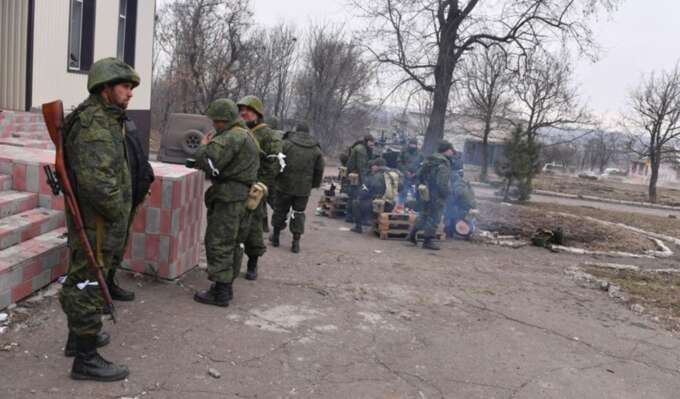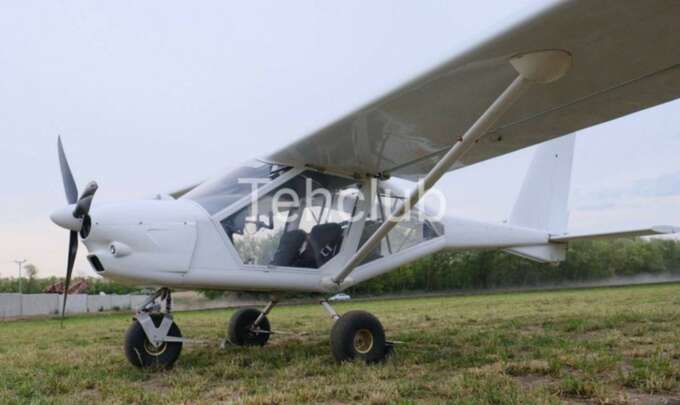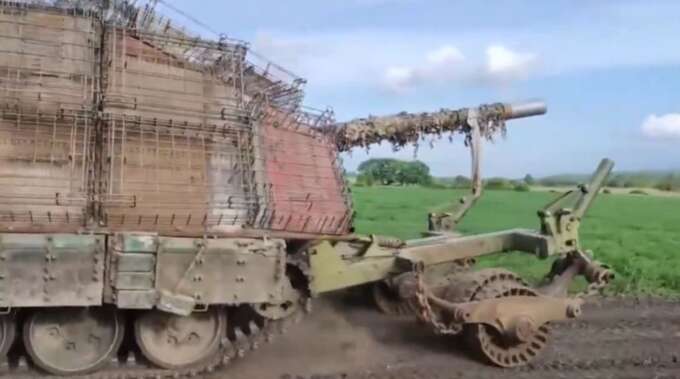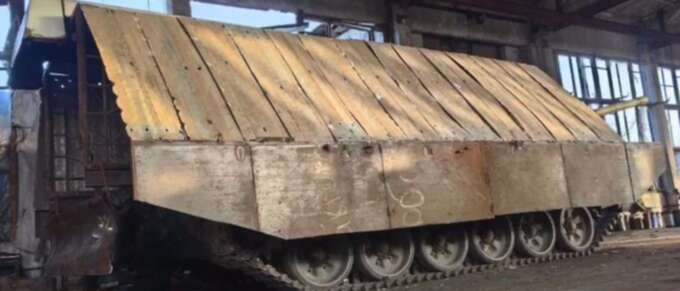The First Cyberpunk War: Ukraine conflict melds modern and ancient weaponry
In the Russian-Ukrainian war, advanced technologies are bizarrely mixed with century-old inventions.
Starlink-guided FPV drones with thermal imagers drop 1950s shells or ram other drones using an attached stick. “Crop dusters” shoot down drones with small arms — or are transformed into unmanned drones themselves. Behind the front lines, a diverse range of transport moves about, from horse-drawn carts to electric unicycles. Russians launch assaults riding on motorcycles, a tactic not even used in World War II, while WWI-era Maxim machine guns updated with modern thermal imagers protect the skies. The Insider describes how the co-evolution of modern technologies and century-old equipment has turned the battlefield into a “Mad Max” sequel.
Cold war legacy
At the beginning of the Russian-Ukrainian war, both sides had similar arsenals, primarily consisting of Cold War-era legacy equipment that had been modernized to varying degrees. Russia had an edge in operational-tactical reconnaissance drones, electronic warfare systems, and long-range strike capabilities, which included stocks of cruise and ballistic missiles. Ukraine, on the other hand, had better-developed digital communications, as well as modern anti-tank weapons supplied by the West. However, the core of both militaries was still based on the Soviet army of the 1980s.
The beginning of the war in Ukraine looked like a clash between two Soviet armies of the 1980s
However, this situation couldn’t last. The technological and industrial base that had supported the Soviet army was no longer in existence. Both sides had to scrape the bottom of the barrel before turning to modern solutions. Signs of this technological regression appeared even before the full-scale invasion began, as Ukrainian territorial defense fighters were issued Degtyarev machine guns from the late 1920s. Shortly after the invasion started, those mobilized in the Russian-controlled “people’s republics” in the Donbas received Soviet SSh-68 helmets — and, in some cases, SSh-40 helmets from World War II — along with Mosin-Nagant rifles developed in 1891.

A mobilized soldier from the “DNR” and “LNR” formations with a Mosin-Nagant rifle, spring 2022.
Armchair Warlord
Both sides had to improvise on the fly. During the battle for Kyiv, local residents helped direct Ukrainian artillery, including heavy “Pion” self-propelled guns, using consumer-grade quadcopters. The Russians, faced with non-functional communication systems that had eaten up significant pre-war investment, resorted to buying easily intercepted Chinese Baofeng radios.
The development of strike-reconnaissance UAVs accelerated after the initial Russian “Blitzcringe” and the beginning of the Donbas offensive. By this time, both sides had experienced artillery ammunition shortages — Ukraine’s Soviet-era stocks were depleted first, followed by Russian “shell hunger” after a series of effective strikes on their supply depots by Ukrainian forces using American HIMARS MLRS.
Rather than following Soviet-era manuals and resorting to “area fire,” small reconnaissance drones now directed each precious shell precisely on target. Additionally, grenade drops from drones allowed for the destruction of small, lightly armored targets without the need for artillery.
The “shell hunger” affecting both sides made drones crucial for the effective use of artillery
This is where the pre-war shortcomings in the Russian army’s drone provision became evident. The late Vladlen Tatarsky, a Russian “milblogger” assassinated in St. Petersburg in April 2023, specifically mentioned the acute shortage of standard Orlan drones in frontline units. Additionally, due to its poor-quality optics, the Orlan was better suited for adjusting fire for battalions and batteries targeting large enemy concentrations, a tactic the Ukrainian army quickly abandoned. Fire missions had to be issued to individual guns, meaning almost every crew now needed a drone. This compelled the Russians, following the Ukrainians, to start purchasing commercial UAVs with volunteer funds and mastering specialized artillery programs for smartphones.
In the absence of a secure military messaging system, the Russians turned to Telegram as a substitute, while the Armed Forces of Ukraine went further by using the gamer-favored Discord service at command posts, enabling group video calls and simultaneous live viewing of multiple UAV broadcasts.

Use of Discord at a Ukrainian command post, March 2023.
The New York Times
The Russian artillery arsenal was expanded with D-20 howitzers retrieved from storage, followed by D-1 models dating back to 1943. The main advantage of the latter was their ability to use obsolete artillery rounds that had been gathering dust in warehouses since the mid-20th century. The Ukrainian Armed Forces, along with Western artillery, also put Soviet D-44 guns, developed in 1944, into service, some of which were mounted on MT-LB vehicles, transforming them into makeshift self-propelled guns.
Over time, both sides began producing so-called “gun trucks” (1, 2) — guns crudely mounted on truck chassis. Later, due to the shortage of artillery, some Russian soldiers resorted to using outdated systems like rifle grenades and even bows with arrow tips made from mounted grenade launcher ammunition.
Starlink-guided drones and unmanned “crop dusters”
The use of various unmanned systems has become a hallmark of the Russian-Ukrainian war. While their significance is sometimes exaggerated — largely due to videos online that showcase only successful attacks — drones indeed play a crucial role on the battlefield. This is especially true for the Armed Forces of Ukraine (AFU), which faced severe shortages of artillery ammunition during the winter of 2023-2024 due to delays in passage of a U.S. military aid bill.
Like any advanced weapon, drones are rapidly evolving. Today, they are often equipped with specialized warheads, thermal imagers, and machine vision that enables them to autonomously home in on designated targets. Originally derided as “wedding [photography] drones,” they have since transformed into Starlink terminal carriers, extending control over strike drones to greater distances. Satellite communication terminals were even hacked to circumvent territorial restrictions imposed by Elon Musk’s company.
The Ukrainian military-industrial complex has also developed an answer to Iran’s “Shahed“ drones (details on those are available in the article “Drone Wars: How UAVs Became a Defining Factor in the War in Ukraine“). “Lutyi“ drones frequently appeared in western regions of Russia, and soon Ukrainian drones were capable of reaching as far as the central region of Tatarstan. This was achieved by converting light aircraft from the Ukrainian company Aeroprakt into drones. The AFU’s creation of the world’s first Unmanned Systems Forces elevated drones to a distinct military branch, equivalent in importance to artillery or air defense.

Unmanned Aeroprakt “crop duster”
Ukrainian brigades are progressively integrating Strike Unmanned Aerial Complexes (RUBpAK) companies, with some forming entire UAV battalions. In contrast, the Russian army lags behind organizationally — strike drone companies are only emerging at the level of troop groupings. Standard UAV companies in Russia combine operators of reconnaissance and strike drones and thus fall short in firepower when compared with their Ukrainian counterparts. Nonetheless, Russian forces maintain an advantage in fixed-wing reconnaissance drones, capturing footage of strikes on Ukrainian targets at a distance of up to 150 kilometers from the border.
Alongside unmanned aerial vehicles, maritime and ground unmanned systems have seen widespread adoption. At sea, the Ukrainian Navy and special services, employing kamikaze unmanned surface vessels, inflicted substantial losses on the Russian Black Sea Fleet, leading to the dismissal of the fleet’s commander and the evacuation of most ships from Crimea to Novorossiysk on the eastern coast of the Black Sea.
Ukrainian unmanned boats are controlled via Starlink, with their latest versions carrying air-to-air missiles for combating helicopters and “Grad” MLRS launchers for shore strikes. Reports indicate unmanned surface vessels have even been equipped for remote mine deployment. In response, Russia showcased its own series of unmanned boats at the “Fleet-2024” exhibition. However, since Ukraine lacks large surface ships, the practical utility of such developments on the Russian side is limited.

Test run of a Ukrainian maritime drone Emanuele Satolli.
The Wall Street Journal
Ground unmanned systems occupy their own niche. They perform a variety of functions, including remote mining (sometimes directly at enemy positions), demining, destruction of enemy objects, and the forward deployment of electronic warfare systems. There has even been an attempt to convert a captured Ukrainian tank into a ground drone, which looks more like a revival of past technologies, as the first remotely controlled tanks were used by Soviet troops during the Soviet-Finnish War. (Ground drones have turned out to be extremely important for logistics, which will be discussed below.)
While drones in the land, sea, and air domains lead military-technical progress, the methods to counter them form a curious blend of various technologies. Following the initial “Shahed” raids on Ukrainian cities, social media circulated a guide on shooting down drones with small arms, reminiscent of Soviet infantry manuals for countering German bombers.
Passive protection of armored vehicles from kamikaze UAVs peaked with the introduction of anti-drone grills for added protection.

Military analysts note that this trend is causing tanks to resemble their World War I predecessors, many of which lacked rotating turrets and were primarily designed for storming fortified enemy positions.
Russian tanks increasingly resemble their World War I counterparts
To defend against drones, so-called “EW monsters,” also known as “tsar-EW,” are sometimes employed. They offer a combination of various electronic warfare systems which provide effective protection against enemy tanks at Russian oil depots and refineries, which frequently come under attack from Ukrainian drones.

The methods used to counter drones appear highly unconventional. In Ukraine, alongside radar, long-range Russian drones are detected using a sound reconnaissance system involving 8,000 mobile phones installed on towers. Meanwhile, one of the most effective anti-“Shahed” measures has been to employ early 20th century Maxim machine guns equipped with water-cooling systems for sustained, prolonged firing.
The Russians have not yet developed a fully operational system of mobile anti-drone groups akin to those of the AFU. Consequently, the Russians still rely on helicopters and fighter jets to hunt Ukrainian UAVs. In turn, Ukrainians engage Russian reconnaissance drones by firing at them from Soviet-era Yak-52 piston-engine aircraft. They even employ tactics reminiscent of World War I, which have seen crew members of unarmed aircraft fire personal weapons. This approach appears effective, as evidenced by the downed UAV tally seen on one of the Yaks.
Other types of drones are increasingly prominent in countering UAVs. Both Russian and Ukrainian FPV kamikaze drones successfully target ground and maritime drones. Ukrainian UAV units employ “active defense tactics,” using electronic reconnaissance to detect enemy drones and dispatch their own drones to intercept the enemy’s.
Russian “drone handlers” use air ramming against not always work.
A safer alternative for interception seems to be the Russian “net launcher” system, which literally drops a net onto the enemy drone, entangling its propellers and causing it to fall. In response, Ukrainians utilize the “innovative” “Stick” system, which, despite its simplicity, effectively brings down enemy UAVs.
In parallel with these straightforward methods, significant strides in electronic warfare and electronic reconnaissance have also been made. In Ukrainian urban areas, GPS spoofers are increasingly being employed during Russian incursions, diverting the shown locations of residents’ vehicles to unexpected destinations — such as Turkey. Similar systems aimed at disrupting drone navigation appear to have been deployed in Russian communities as well.
Renowned Ukrainian “drone handler” Robert Brovdi, known by the call sign “Magyar,” is developing a strategy to blanket the entire frontline with systems capable of detecting and promptly suppressing enemy drones. Meanwhile, Ukrainian and Russian volunteers are sending personal drone detectors to the frontline. These are capable of alerting soldiers to the approach of UAVs and even of identifying their type. The Russian Ministry of Industry and Trade is investing millions in directional jamming stations and interceptors to safeguard industrial facilities. Russian “military correspondents,” on the other hand, showcase man-portable electronic warfare systems. However, these are noted to carry certain health risks for the operator (1, 2).
“Assault” vehicles and logistics
The Insider’s analysis of the “evolution” of the Russian army during two years of conflict directed significant attention towards its substantial losses of armored vehicles, which have degraded the level of mechanization in frontline units to a situation akin to the 1940s, a fact highlighted by some Z-bloggers. The AFU face a similar issue. Recently, Ukraine’s National Police announced the formation of three combined rifle brigades. A “rifle” designation, unlike motorized rifle or mechanized units, indicates insufficient tanks and armored vehicles for all personnel. In an effort to safeguard the remaining tanks in service with the AFU, the vehicles are undergoing a modernization process that includes the installation of “mangals” and explosive reactive armor (ERA), often of Ukrainian origin.
In response to shortages of ERA components for armored vehicles, Russians are resorting to makeshift solutions such as using demining charge explosives. To enhance troop carriage capabilities, modifications are being made to MT-LB armored vehicles and BMP-1 infantry fighting vehicles, expanding their troop compartments and removing gun turrets. In cases where armored vehicles are entirely unavailable and a “meat grinder assault“ remains necessary, Russian forces now employ “assault motorcycles,” along with infamous Chinese “golf carts.”
During World War II, motorcycle units were often found in the ranks of the Wehrmacht and Red Army, but they played the role of reconnaissance and light cavalry and did not use their equipment when storming enemy positions. Currently, there is a belief that motorcycles enable swift passage through zones vulnerable to Ukrainian artillery and drones. However, based on available evidence, this strategy is not always successful. Some motorcycles are equipped with special “moto-mangals,” yet even within Z-circles, doubts persist regarding the effectiveness of these structures, which evoke comparisons to the post-apocalyptic “Mad Max” franchise.

Moto-mangal
The use of motorcycles for frontline logistics appears more viable, with discussions allegedly underway about forming motorcycle platoons within Russian regiments and brigades. The Russian Ministry of Defense has showcased light refuelers based on motorcycles, alongside buggies and UAZ off-road vehicles. The need to disperse positions, coupled with the bulkiness and visibility of conventional trucks (and their potential scarcity), has led to the deployment of exotic transport types in frontline zones, including quad bikes, motor cultivators, and even the occasional horse-drawn cart. Some personnel utilize modern personal transport like electric unicycles, e-scooters, and e-bikes.
Advanced “micro-logistics” methods now incorporate electrified carts and robotic platforms, crucial for delivering supplies to the frontline and facilitating evacuations. UAVs frequently supply forward positions, while both Russian and Ukrainian forces have developed heavy multicopter drones capable of transporting supplies and even fully equipped soldiers.
Yet amidst these futuristic innovations, more primitive means of unmanned communication between positions exist. For instance — a bathtub pulled on a cable between trenches by Russian military personnel until it was targeted by a Ukrainian drone.
Over the course of the Russian-Ukrainian war, the juxtaposition of outdated military equipment, a scarcity of modern weaponry, and the widespread availability of commercial electronics has resulted in a most unconventional blend of 19th and the 21st century technologies. While not all of these inventions find practical application on the front lines, each day sees the emergence of new (or rediscovered) devices in “garage” laboratories and combat zones, capturing the imagination of onlookers. As was noted in a recent article by The Insider, given the unfortunate persistence of the war and the escalating demands placed on armies, the diversity of technological solutions is bound to continue expanding.
Read more similar news:
Comments:
comments powered by Disqus


































